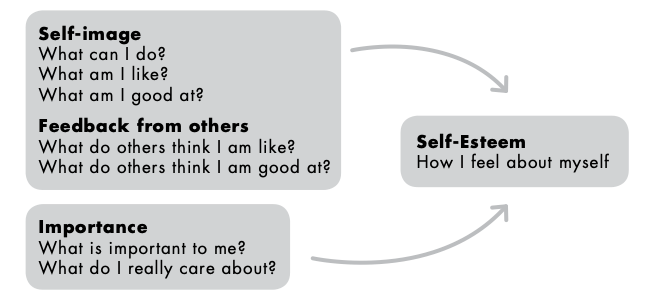Teenagers Series Part 6: Teenagers and self-esteem
This article explores the importance of teenage self-esteem and body image.
There always appears to be a lot of information about self-esteem and teenagers, but do we ever really explain to teenagers what self-esteem, self-image and body image really are? The following article includes how to explain these important concepts to your teenagers as well as advice and tips for you to support the development of their self-esteem.
In this article:
- Building self-esteem in teens is important
- Explaining self-esteem to your teenager
- Important points about teenagers’ self-esteem
- Self-esteem and body image
1. Why is Building self-esteem important?
Teenagers are going through substantial physical and emotional development, and this can impact their self-image and how they feel about themselves.
With all these changes, it is understandable that many teens will experience confusion and insecurity, so self-esteem is an important topic for fathers of teenagers to talk about.
There is clear evidence that fathers can have a distinct impact on their teenager’s self-esteem. In particular for girls, where fathers have been shown to have more impact on a daughter’s self-esteem than mothers do.
As a girl moves into adolescence with her changing and maturing body, fathers need to be cautious about comments and attitudes about body image, even if it meant as a joke.
There is also growing concern around self-esteem and young males and fathers can be a positive role model and support for healthy body image and self-esteem for their sons.
A young person with healthy self-esteem is more likely to display positive behavioural characteristics and have healthy relationships with their peers, while they are less likely to be involved in unhealthy or undesirable behaviours.
2. Explaining self-esteem to your teenager
Explaining self-esteem?
- Self-esteem is a person’s evaluation of their own worth. It is the way we feel about ourselves.
- Healthy self-esteem is about accepting yourself as you are and feeling comfortable with yourself.
- Low self-esteem is about wishing you were different or wishing you were someone else.
How does self-esteem work?
Self-esteem is a combination of our thoughts about our self-image, what is important to us, and feedback from others.

Self-image
Self-image is our thoughts and ideas about how we see ourselves now in all the different areas of our life.
“What can I do? What am I good at? What are my strengths?”
We look at our features, abilities, strengths and talents in common image areas such as:
- Physical appearance (What do I look like?)
- Social acceptance (How do I get along with others?)
- Creative ability (What are my creative skills)
- Athletic ability (What are my athletic skills?)
- Academic ability (What are my academic skills?)
- Behaviour (How do I behave or act?)
What is important to me?
We all compare how we see ourselves in a particular image area with what importance we place on this area. When there is a good balance between how we see ourselves and the importance we place on this particular area we usually feel good about ourselves.
What does LOW self-image look like?
Sometimes people have a low self-image in an area of their life that they believe is very important. For example: A boy thinks he is no good at sport – but sport is very important to him. This can result in him having low self-esteem.
What does HIGH self-image look like?
Sometimes people have a high self-image in a particular area but believe that this area of their life is not important. For example: A girl was really good at netball but didn’t think sport was as important as schoolwork. This girl’s self-esteem might be fine if she was also doing well at school. However, if she was not doing so well and judging herself only on her schoolwork this may make her self-esteem suffer.
“What do other people think of me?”
We all have people in our lives that we feel are important. These people are usually:
- Family members;
- Friends;
- Peers (other people our age);
- Teachers; and
- Anyone else that we feel is important in our lives. (role models)
We add the feedback from these people to the feed to our own thoughts about ourselves, plus what is important to us to get our self-esteem.
3. Important points to know about teenagers’ self-esteem
- Physical appearance is the image area teens are most likely to nominate as the most important to them in judging their self-image.
- In research, teenagers nominated physical appearance as the ‘image areas’ they are usually most unhappy with.
- Teens tend to judge themselves in their ‘image areas’, more harshly than any other age group.
- Teenagers often judge their appearance on images from the media, social media and other images that are not always realistic.
- If their ideal image, of what they want to be like is too high, they will always fall short.
- Feedback from their peers is the most important to most young people.
- Teenagers worries of what their peers might think of them can be a barrier for them trying new things.
Signs of low self-esteem may include:
- Negative self-talk and comparisons to others
- Focusing on the negatives and ignoring his/her achievements
- Avoiding new things and not taking up opportunities
- Fear of failure or embarrassment
- Low levels of motivation and interest
- Not accepting compliments or positive feedback
- Shows mixed feelings of anxiety or stress
How can parents help?
Sometimes parents are confused as to why their teenager is showing signs of low self-esteem and yet appear to be doing well in everything at school or at sport etc.
- Be aware that their judgement of themselves may not be based on the same things criteria yours.
- Try to find out how they are really feeling and what their expectations of themselves are. It might be that they are experiencing a relationship problem or are not happy with the way that they look.
- Even though they may appear to be doing well, there may be something else that see as being more important at this stage in their life. By talking them though their thoughts and feelings you can help them to have a more realistic view of themselves as an individual.
- Your feedback is still important, and your support and guidance needed even if they appear to be pulling away.
How can you support healthy self-esteem?
- Help your teenagers think about their abilities and what they are capable of in a realistic way, e.g. “You are driving so well for someone who is just learning.”
- Encourage your teenagers to ‘have-a-go’ at new activities.
- Encourage your teenagers to value a wide range of abilities and get a balanced view of all their strengths and weaknesses.
- Support your teen to establish realistic and achievable personal goals for improvement.
- Set aside time to listen to your teenagers and show them that you value what they have to say.
- Help them to be more capable and independent, e.g. caring for their own belongings, managing their money or being involved in developing agreements around their boundaries.
- Encourage your teenagers to think about images they see online, TV and movies and evaluate the level of realism of these images to us in our day to day lives.
4. Self-Esteem and Body Image
Teenagers undergo and have to cope with numerous physical changes. Plus, we know that teenagers are usually very concerned with their physical appearance and what other people their own age think of them. This leads to teenagers being sensitive and vulnerable to body image worries.
At this age young people can be over critical of themselves and may feel they are too fat, too skinny, too tall or too short. This feeling can lead them to spend time wishing they were different.
When they don’t like something about themselves, it can result in self-esteem and body image problems. At this age young people can be over critical of themselves, plus teens are also more prone to thinking that others, particularly their peers, view them as they view themselves.
Unrealistic images
If teenagers who are going through many physical changes are comparing themselves to unrealistic images of people from social media, TV or in movies, there is a huge amount of pressure to live up to those images.
This has been an ongoing issue over time for girls, but we are now seeing that more and more boys are being impacted by the pressures of online image and the poor body image.
While many girls are influenced by images of celebrity women’s shapes and figures and flawless skin, boys are often comparing themselves to muscular male athletes and action heroes.
Even though these influencers are often older men and women, this comparison can leave many teenagers feeling dissatisfied with their own bodies.
Body image and teasing
Bullying and teasing about appearance and sexuality can become a problem at this age if teenagers are not made aware of their attitudes, behaviours and how they can affect others.
It seems that it is also the early-developing girls and the late-developing boys who may be most at risk of bullying during this developmental stage.
Boys who are still developing are generally smaller is stature and appear more vulnerable to ridicule and bullying.
Early developing girls are very prone to teasing and unwanted comments about their appearance. Issues about body image and appearance are very sensitive topics particularly to girls at this stage in their development.
Parents also need to be aware what might have been meant as a light-hearted comment about a teenager’s body shape or size can be very hurtful and create much anxiety.
Comments like “She is carrying a bit of puppy fat” or “He is so small compared to his class-mates” can be cause for great concern for your child. This is time of increased sensitivity about body growth and shape.
Top Tips for how to support your teens with healthy body image
- Be a good role model. Examine your own body image and self-esteem and think about the messages you are projecting to your teenager.
- Compliment your teenager where-ever possible. Fathers are an important source of reassurance in this area for both boys and girls.
- Be supportive as they explore new looks and styles. This is a natural way of them exploring their identity and self-image.
- Listen to their concerns about body shape and appearance. Reassure your teenager that their physical changes are normal and that everyone develops at different times and rates.
- Be aware of the impact of negative body talk around your teenagers, about your own body, other people’s or theirs.
- Don’t put a lot of emphasis on physical appearance. Try to talk to your teenager about all the different aspects that make up a person, such as personality, skills and outlook on life.
- Keep the focus on being healthy. Emphasise a healthy lifestyle, eating, exercise and having fun.
- Teach realistic expectations. Analyse images of celebrities or influencers together with your teenager and discuss whether they are healthy or even realistic images to compare themselves to.
Have you enjoyed this article? For more insight on social issues affecting fatherhood, check out our blog.
This series has been designed to give an insight into the workings of the teenage brain and some tips to help to navigate parenting your teenager. These learnings are based on our research and years of experience supporting fathers and father-figures. But the fact is, everyone’s situation is different, so feel free to be creative, and adapt our wisdom to suit your circumstances. In this series we look at:
- Teenage brain development
- Communicating with your teenager
- Staying connected with your teenager
- Setting the boundaries with teenagers
- Teenager self-esteem and body image
- Teenage relationships, friends and groups



